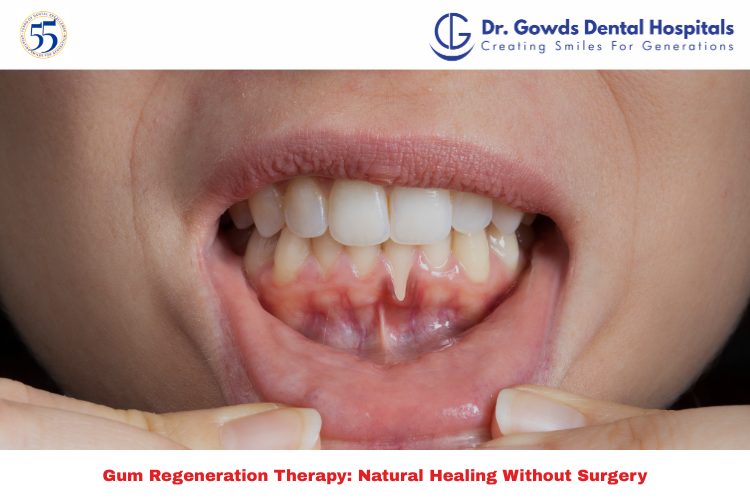Schedule Appointment




Gum recession and chronic gum disease are more than cosmetic issues. They can cause tooth loss, increased sensitivity, and unhealthy oral care. Luckily, advancements in gum regeneration therapy are changing the way dental health practitioners are treating them.
One emerging innovation in dental science is keratin gum regeneration therapy. While still not widely used in every dental health clinic, this form of treatment is a non-surgical, effective alternative to traditional grafts, and allows patients to restore gum tissue safely, and comfortably.
Gum regeneration treatment is best defined as procedures that replace lost or destroyed gum tissue as well as tackle the underlying factors that cause inflammation and gum recession; it is important to note, that while cleaning, or scaling, is helpful, it is not the same as gum regeneration therapy.
Keratin-based gum therapies are part of this exciting, advanced area. Keratin-based materials from a biocompatible source are used to stimulate the body’s own healing properties to regenerate gum tissue effectively and combined with natural keratin provides gum tissue with the strength it needs. Gum disease leads to a weakening of the structural integrity, compared to normal gum tissue, which is often lost because of gum disease.
Advancements in regenerative dentistry and keratin to utilise keratin-based solutions has decreased patient discomfort during treatment, allowed for a faster recovery time, reduced systemic complications, and better outcomes. There are now even patients who were worried about having gum surgery and opted for newer, comfortable therapy.
Human hair, skin, and nails naturally contain keratin – a protein which has been recently utilized in dental therapy by placing keratin-enriched materials into certain areas of gums. The keratin forms a scaffold that does several things:
– All the above positively influences gum tissue regeneration
– Promotes healing and cell growth
– Strengthens and stabilizes tissue integrity
– Reduces post-treatment inflammation
Once the keratin is placed, the keratin framework simply integrates with the surrounding tissues and promotes the body’s ability to repair by providing a scaffold to restore volume and the original structures without the need for incisions or stitches.
The keratin gum treatment method provides a biologically safe, safe, and safe environment created to support for new tissue growth, making it perfect for individuals suffering from mild to moderate gum recession or periodontal disease. Keratin-based gum tissue treatment is proving to be equally successful among others looking for a natural and non-invasive option in their oral care plans.
Here’s why more patients around the world are exploring keratin therapy for gums:
While keratin therapy for gums is not yet standard in most dental clinics, its results are promising for future mainstream adoption.
You may benefit from keratin-based gum regeneration therapy if you experience:
It is especially recommended for patients who want to avoid the discomfort and downtime associated with surgical grafting procedures.
The basic steps to the procedure will differ according to your provider and level of research know-how, but usually consist of the following:
1. Evaluation and Imaging – A comprehensive evaluation of your overall gum health will be performed through high-resolution x-ray imaging and probing instruments.
2. Preparation of the region – Cleaning and preparation of the surgical area should include cleaning and sterilization, and removing plaque, calculus etc, as necessary.
3. Application – Placement of matrix or membrane rich in keratin over the targeted areas.
4. Support for healing – Recommendations for care after and oral hygiene for two weeks, and possible medication to assist with bone healing.
Recovery times are usually fast, and most patients will resume most activities in 1-2 days. After several weeks, patients will appreciate thicker gums, less sensitivity and dry mouth, and improved gum line.
Patients should be encouraged to eat as soft of a food diet as possible for the first couple of days, avoid irritative brushing, and attend scheduled follow up visits to measure healing progress.
With the advancement of dental innovation, keratin gum regeneration therapy could possibly become more accessible to patients all over the world. Being non-invasive and biocompatible is promising for an approach to treat gum recession as an alternative to harvesting traditional grafts.
Even though this specific treatment is not available yet in every clinic, the increased interest in keratin gum regeneration therapy between dental practitioners shows the overall trend to providing patients with regenerative and minimally invasive oral health care options.
If you are investigating ways to manage gum recession or improve gum health, consider asking your periodontist or dental health care provider if regenerative treatment options, such as keratin therapy, are a potential option for you.
Gum problems do not always have to end in surgery or permanent damage. Patients now have safe, simple, and comfortable methods gon gum regeneration therapy, especially keratin therapy for gums.
The advancements in gum healing are such that it can be easier and less intimidating. For sensitivity issue, gum recession or early gum disease, there is now a safe, simple, and non-invasive way to help improve gum health.
Talk to your dental caretaker to determine the best possible care for your gum health – and continue to learn about the advances in regenerative techniques – such as gum regeneration based on keratin.
While results are long-lasting, continued oral care is essential to maintain gum health. Regular brushing, flossing, and dental visits are key.
Most patients experience little to no pain. Discomfort is minimal compared to surgical grafts, and local anesthesia may be used for added comfort.
Mild swelling may occur, but full healing typically takes 1–2 weeks. Noticeable improvements often start within the first week.
In many mild to moderate cases, yes. However, severe recession may still require grafts or a combination approach.
Yes. It’s biocompatible and well-tolerated by most individuals. A thorough consultation will determine the best treatment plan.